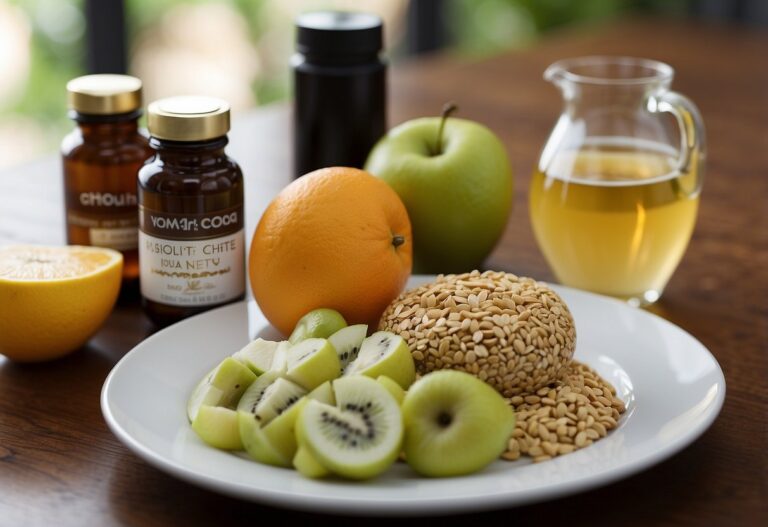Losing belly fat can be a challenging journey, but it’s not impossible. With the right workout tips, you can target this stubborn area and see effective results.

It’s not just about doing endless sit-ups. Combining different exercises and routines can help you achieve a flatter stomach.
Let’s explore the key strategies that really make a difference.
High-Intensity Interval Training (HIIT)
High-Intensity Interval Training (HIIT) is a great way to burn belly fat swiftly.
You start with short bursts of intense exercises followed by brief rest periods. This method maximises calorie burn and keeps your metabolism high even after the workout.
Incorporating exercises like high knees can be highly effective.
Stand with your feet hip-width apart, lift your knees as high as possible, and run in place. This engages your core and adds intensity.
Try an EMOM workout for variety.
Set a timer for 20 minutes. Do the listed reps or time for each exercise and rest for the remainder of the minute. At the start of the next minute, do the next exercise. This keeps your workout structured and challenging.
Adding both upper and lower body exercises can also help.
Perform each exercise for 30 seconds, followed by 15 seconds of rest. Repeat the circuit multiple times. This method ensures a full-body workout that targets belly fat effectively.
Whether you’re new to fitness or an experienced athlete, HIIT is adaptable.
You can modify the exercises to suit your fitness level. Make a routine that fits your schedule and stick to it. Consistency is key to seeing results.
Strength Training
Strength training is essential for losing belly fat. Lifting weights doesn’t just build muscle; it also boosts your metabolism. This helps burn more calories, even when you’re not working out.
Focus on exercises like squats, deadlifts, and bench presses.
These moves engage multiple muscle groups, providing more bang for your buck.
Incorporate high-intensity weight lifting.
Aim for a 6-12 rep range to build muscle, which helps burn more fat over time.
Work with weights three to four times a week. Consistency is key.
Eat More Soluble Fibre
Eating more soluble fibre can make a big difference in losing belly fat.
Soluble fibre helps you feel full longer, reducing the urge to snack on unhealthy foods. Foods rich in soluble fibre include oats, beans, and fruits like apples and berries.
You can add more soluble fibre to your diet by eating whole grains or adding a spoonful of chia seeds to your breakfast.
Soluble fibre can also help stabilise your blood sugar levels, which means fewer cravings during the day.
If you’re looking for a simple way to boost your diet, consider adding more soluble fibre-rich foods.
Try including more veggies like carrots and Brussels sprouts, which are also high in soluble fibre. Starting with these small changes can lead to noticeable results in your fitness journey.
For more details, you can visit this article.
Limit Sugar Intake
Reducing sugar in your diet can significantly help in losing belly fat.
High intake of sugar, including refined and natural sugars, can contribute to weight gain.
When you consume too much sugar, your body stores the excess as fat, especially around your belly. This can make it harder to achieve a flat stomach.
Try to read food labels and be aware of hidden sugars in foods like sauces, dressings, and drinks.
Opt for fresh fruits instead and limit sugary snacks and beverages.
Reduce Refined Carbs

Cutting back on refined carbs can make a big difference in losing belly fat.
Foods like white bread, pastries, and sugary drinks spike your blood sugar and can lead to weight gain around your middle.
Instead, focus on whole grains like brown rice, oats, and whole wheat bread. These carbs keep you fuller for longer and provide more nutrients.
You might find that swapping out refined carbs for whole grains doesn’t just help reduce belly fat but also improves your overall energy levels throughout the day. Healthy swaps like these are small changes that can have a big impact.
Increase Protein Intake
To lose belly fat, boosting your protein intake can be very effective.
Eating more protein helps keep you full longer. This reduces the chances of snacking on unhealthy foods. Aim for sources like lean meats, fish, beans, and nuts.
Protein also plays a key role in building muscle.
More muscle can increase your metabolism, helping you burn more calories even at rest.
Try to include protein in every meal.
For example, you could add eggs to your breakfast or chicken to your salad. This simple change can make a big difference.
Eat protein-rich foods that you enjoy to make it easier to stick to your plan.
Consider trying new recipes to keep things interesting. A high-protein diet can be both tasty and satisfying if done right.
For more detailed tips on a high-protein diet, check out this high-protein diet plan.
Drink Green Tea
You might be surprised, but drinking green tea can help with belly fat loss.
Green tea contains antioxidants called catechins, which are known to support metabolism.
The caffeine in green tea also boosts energy levels. This can help you stay more active throughout the day.
You don’t need to drink a lot. Start with a cup in the morning and see how it works for you. Try incorporating it into your daily routine for better results.
Stay Hydrated

Drinking enough water is key to losing belly fat.
When you exercise, you sweat and lose fluids. Replacing these is important. If you’re dehydrated, you might feel tired and even hungry.
Always keep a water bottle with you.
Sip water before, during, and after your workout.
Don’t rely just on thirst. Sometimes, by the time you feel thirsty, you’re already dehydrated. Aim for at least eight glasses of water a day, more if you’re active.
Get Enough Sleep
Getting enough sleep is crucial for losing belly fat.
Aim for seven to nine hours of quality sleep each night. This helps your body recover and function properly.
Poor sleep can lead to weight gain, especially around your middle.
When you’re tired, your body craves unhealthy foods, making it harder to stick to your diet.
Quality rest also affects your stress levels. High stress can increase belly fat.
Ensure you follow a regular sleep schedule to help manage your stress and keep your fat loss on track.
Track Your Calories

Tracking your calories is an important step in losing belly fat.
You need to know how many calories you consume each day. Use apps or journals to write down everything you eat and drink.
Keep an eye on portion sizes. Even healthy foods can add up in calories if you’re not careful.
Check labels for serving sizes and calorie content. It helps you stay within your calorie goals.
Consider the balance of proteins, carbs, and fats in your meals. Eating the right mix can help in your weight loss journey.
Stay consistent with tracking. It will show you patterns and help you adjust your diet effectively.
Understanding Belly Fat
Knowing about belly fat means understanding its different types and what causes it to accumulate. This is important for anyone trying to lose weight and improve their health.
Types of Belly Fat
There are two main types of belly fat: visceral fat and subcutaneous fat.
Visceral fat is the fat that surrounds your organs. It’s hidden deep inside your belly and can increase your risk of serious health problems like heart disease and type 2 diabetes.
On the other hand, subcutaneous fat is the fat just under your skin. This type of fat is visible and can be pinched. While subcutaneous fat is less harmful than visceral fat, having too much of it can still affect your health.
Having an awareness of these two types of fat can help you focus on reducing the more dangerous visceral fat through specific exercises and diet changes.
Causes of Belly Fat Accumulation
Several factors can lead to the accumulation of belly fat.
Poor diet is a big contributor. Eating high-sugar, high-fat, and processed foods can lead to weight gain, especially around your belly.
Lack of exercise is another major factor. Not being active enough means you’re not burning the calories you consume, which can cause fat to build up.
Stress can also result in more belly fat. Stress hormones like cortisol can trigger fat storage in the belly area.
Other factors include genetics, ageing, and sleep patterns.
As you get older, your metabolism slows down, making it easier to gain weight. Genetics can influence where your body stores fat, and poor sleep can affect your weight as it disrupts hormone levels related to hunger and fat storage.
Creating a Workout Routine
To lose belly fat effectively, focus on incorporating both cardiovascular exercises and strength training into your workout routine.
Importance of Cardiovascular Exercises
Cardiovascular exercises are essential for burning calories and improving heart health.
Activities like running, cycling, and swimming increase your heart rate, helping you burn fat more efficiently.
Running, especially on an incline, is an excellent way to challenge your body and engage your core and lower-body muscles (source).
Consistency is key.
Aim to get at least 150 minutes of moderate-intensity cardio per week, or 75 minutes of high-intensity cardio. This can be broken down into 30-minute sessions, five days a week.
Choose activities you enjoy to make it easier to stick with your routine.
Interval training, alternating between high and low intensity, can be particularly effective in burning belly fat.
Role of Strength Training
Strength training is vital for building muscle, boosting metabolism, and maintaining overall body strength.
Incorporating exercises like squats, deadlifts, and lunges helps you maintain muscle mass while losing fat.
When you build muscle, your body burns more calories at rest.
Focus on compound movements that work multiple muscle groups simultaneously.
For example, medicine ball twists or pelvic tilts are great for targeting your core muscles (source).
Strength training should be done at least two days a week.
Make sure to give your muscles time to recover, ideally 48 hours between sessions focusing on the same muscle groups.
Combining strength training with your cardio routine can accelerate your progress towards losing belly fat.
Nutrition and Diet

For effective belly fat loss, it’s essential to focus on both diet and exercise. Your nutrition and dietary habits play a crucial role. Proper diet can make a significant difference in your overall results.
Balanced Diet Principles
To lose belly fat, you need to follow a balanced diet. This means consuming the right mix of nutrients.
Eat a variety of foods to ensure you get everything your body needs.
Include plenty of fruits and vegetables. These are low in calories and high in fibre, which helps you feel full longer. Aim for at least five servings per day.
Choose whole grains over refined grains. Whole grains like brown rice, quinoa, and whole-wheat bread are healthier options. They keep you full and are packed with nutrients.
Incorporate lean proteins. Foods like chicken, turkey, fish, tofu, and legumes are excellent sources. Protein boosts metabolism and helps maintain muscle mass during weight loss.
Healthy fats are important too. Avocados, nuts, seeds, and olive oil provide the fats your body needs without adding too many calories.
Stay hydrated. Drinking water before meals can help control appetite and improve digestion.
Foods to Avoid
Avoiding certain foods can help you lose belly fat faster. Knowing what to reduce or cut out can make a big difference.
Limit sugar and sugary drinks. Sugary foods and drinks are high in calories and low in nutrients. Reduce your consumption of soda, sweetened teas, and desserts.
Cut down on refined carbs. Foods like white bread, pastries, and pasta can spike your blood sugar levels and lead to fat storage. Opt for whole grains instead.
Avoid trans fats. Found in many processed foods, trans fats can increase belly fat. Check food labels and avoid items containing partially hydrogenated oils.
Reduce alcohol intake. Alcoholic drinks can add a lot of empty calories. Moderation is key if you choose to drink.
Processed foods can be problematic. These often contain unhealthy fats, added sugars, and excess salt, all of which can contribute to weight gain.
Lifestyle Changes
Making lifestyle changes can greatly enhance your efforts to lose belly fat. Focusing on improving sleep quality and managing stress can play a significant role in achieving your goals.
Improving Sleep Quality
Getting enough sleep is crucial for weight management.
Aim for 7-9 hours of sleep each night. Poor sleep patterns can lead to weight gain and increased belly fat.
When you don’t sleep well, your body produces more ghrelin, the hunger hormone, and less leptin, the hormone that tells you you’re full. This can result in overeating.
Create a relaxing bedtime routine. Reduce screen time before bed and keep your bedroom cool and dark.
Consider using a white noise machine if you live in a noisy area. Regular sleep schedules also help improve sleep quality.
Go to bed and wake up at the same time every day, even on weekends.
Daily physical activity can promote better sleep.
Exercise regularly but try to avoid vigorous workouts close to bedtime. Instead, gentle activities like yoga or stretching can help you unwind.
Stress Management Techniques
Stress can directly impact your waistline. High stress levels increase cortisol, a hormone that can lead to belly fat. Managing stress is essential for reducing belly fat.
Incorporate relaxation techniques into your daily routine. Deep breathing exercises, meditation, and mindfulness can help lower stress levels. Spend time doing hobbies you enjoy. This can be a great way to relieve stress.
Regular physical activity can also reduce stress. Engage in activities you love, like walking, cycling, or dancing to keep stress levels in check. Talking to friends or family members about your worries can provide emotional support.
Consider professional help if stress feels overwhelming. Therapists or counsellors can offer strategies to manage stress effectively. Sometimes, just talking about what’s bothering you can make a big difference.






